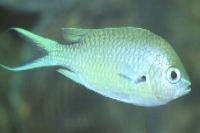 Regular readers of my columns will be aware that I strongly advocate all newcomers to the hobby to gain some valuable experience with fish-only before advancing into the world of invertebrates. There are two very good reasons for this:
Regular readers of my columns will be aware that I strongly advocate all newcomers to the hobby to gain some valuable experience with fish-only before advancing into the world of invertebrates. There are two very good reasons for this:
1) most marine fish are infinitely easier to keep than most invertebrates, and
2) the basics of good marine husbandry can be learnt properly with animals that have a wider degree of tolerance that invertebrates do not have. In short, you can make a few mistakes with fish and it is unlikely to end in complete disaster!
Recommendations
As a result, I often get asked to recommend a few good 'starting' fish. Ones that can be relied upon to be disease-resistant, easy to feed, good community specimens, generally peaceful, colourful and interesting to watch. They must, of course, be widely available through any reasonably stocked marine retailer.
The following selection all have their own widely differing behaviour patterns and occupy various levels in the aquarium. A 4ft aquarium would make an ideal home for this collection, and even though the Tassel Filefish will considerably outgrow the rest, it is a very peaceful fish unlikely to harm any of its tankmates. Should any particular fish prove temporarily unobtainable, I have listed an ideal alternative which may be considered just as suitable.
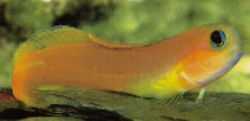 1) Midas Blenny (Ecsenius midas) Size: 4" (Wild & Aquarium) Here is a fish that is full of character, immediately obvious from its curious swimming style, and the way it loves to perch on a suitably high vantage point to survey the aquarium scene. Once a favourite cave or hole has been adopted, it will usually return there on a frequent basis. Giant barnacle shells make ideal retreats and several clusters should be provided throughout the aquarium, preferably situated towards the top of the tank, if possible.
1) Midas Blenny (Ecsenius midas) Size: 4" (Wild & Aquarium) Here is a fish that is full of character, immediately obvious from its curious swimming style, and the way it loves to perch on a suitably high vantage point to survey the aquarium scene. Once a favourite cave or hole has been adopted, it will usually return there on a frequent basis. Giant barnacle shells make ideal retreats and several clusters should be provided throughout the aquarium, preferably situated towards the top of the tank, if possible.
Whilst Midas Blennies are unwilling to share the same aquarium with others of the same, or similar species, they are otherwise very peaceful.
Feeding: Flake, brineshrimp and mysis make an ideal diet and these greedy fishes will often consume enough to make their stomachs bulge!
Ideal Alternative: Bicolor Blenny (Ecsenius bicolor).
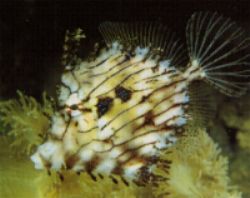 2) Tassel Filefish (Chaetodermis pencilligerus) Size: 7" (Wild & Aquarium) While not the most colourful of marine fish, the Tassel Filefish more than makes up for it by its fascinating shape. Living as it does amongst floating beds of algae, the unusual extensions to the body have been developed as effective camouflage. Fortunately, no such camouflage is required within the aquarium and the Tassel Filefish is happy to swim in open water.
2) Tassel Filefish (Chaetodermis pencilligerus) Size: 7" (Wild & Aquarium) While not the most colourful of marine fish, the Tassel Filefish more than makes up for it by its fascinating shape. Living as it does amongst floating beds of algae, the unusual extensions to the body have been developed as effective camouflage. Fortunately, no such camouflage is required within the aquarium and the Tassel Filefish is happy to swim in open water.
Filefish are related to triggerfishes, but this particular specimen does not share any of their bad habits. Indeed, it is the most gentle of fish, hardly bothering its tankmates at all. It is, however, a fish that grows reasonably rapidly and will eventually require a large aquarium. Even so, smaller fish will be quite safe.
Feeding: Newly imported specimens can occasionally initially be fussy feeders and may require a certain amount of temptation with live brineshrimp, but once settled, the Tassel Filefish will greedily accept most marine foods that are on offer.
Ideal Alternative: Cowfish (Lactoria cornuta).
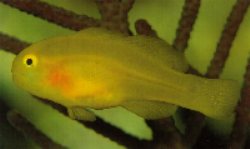 3) Yellow Goby (Gobiodon okinawae) Size: 1.2" (Wild & Aquarium) Despite its diminutive size, the Yellow Goby can be quite territorial towards fish of its own, or similar species. On its own, however, this attractive little fish is peaceful and full of character. Being very weak swimmers they tend to 'hop' from resting site to resting site, observing the aquarium scene quite attentively.
3) Yellow Goby (Gobiodon okinawae) Size: 1.2" (Wild & Aquarium) Despite its diminutive size, the Yellow Goby can be quite territorial towards fish of its own, or similar species. On its own, however, this attractive little fish is peaceful and full of character. Being very weak swimmers they tend to 'hop' from resting site to resting site, observing the aquarium scene quite attentively.
Once in a while, two specimens may be spotted in a retailers tank harmoniously sharing the same aquarium and these may be regarded as a likely pair which could possibly spawn given the right conditions.
The bright yellow coloration is likely to degenerate into a rather dirty brown should water conditions be allowed to slip. This should never be used as a gauge of water quality though, as the fish frequently dies once colour has faded.
Feeding: Will accept any marine fare that is presented as small particles.
Ideal Alternative: Lemon Goby (Gobiodon citrinus).
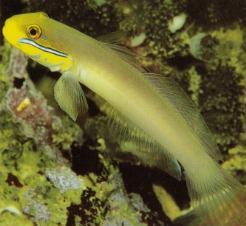 4) Blue-cheek Goby (Valenciennea strigata) Size: 5" (aquarium), 7" (wild). It's easy to see how this fish came by its common name. A neon-blue flash along the side of the head makes it an easy species to identify! Known as a substrate sifter, this goby will spend most of the day taking up mouthfuls of sand, extracting any particles of food and expelling the residue out of its gills.
4) Blue-cheek Goby (Valenciennea strigata) Size: 5" (aquarium), 7" (wild). It's easy to see how this fish came by its common name. A neon-blue flash along the side of the head makes it an easy species to identify! Known as a substrate sifter, this goby will spend most of the day taking up mouthfuls of sand, extracting any particles of food and expelling the residue out of its gills.
Pairs are often seen sifting the sand side by side and make an excellent job of loosening the substrate whilst helping to keep it free from contamination by consuming unwanted food.
These are extremely peaceful fish that are unafraid of being observed.
Feeding: Blue-Cheek Gobies will accept almost any marine fare as long as the particles are small enough.
Ideal Alternative: Orange-Spotted Goby (Valenciennea puellaris).
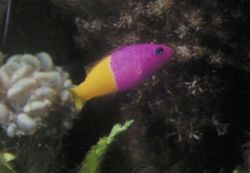 5) False Gramma (Pseudochromis paccagnellae) Size: 2" (Wild & Aquarium). Often confused with the Royal Gramma (Gramma loreto), the False-Gramma can be easily distinguished by the sudden division between the two body colours. In fact, they are separated by a thin white line, but this can be very difficult to see on some specimens.
5) False Gramma (Pseudochromis paccagnellae) Size: 2" (Wild & Aquarium). Often confused with the Royal Gramma (Gramma loreto), the False-Gramma can be easily distinguished by the sudden division between the two body colours. In fact, they are separated by a thin white line, but this can be very difficult to see on some specimens.
In common with the Royal Gramma, it prefers plenty of rocky retreats and dislikes being stranded in open water for long periods.
Although the False-Gramma cannot be described as the best behaved fish in the marine fishtank, any tendency to nip at other species is usually limited to those that have similar coloration, habits or body shape. Therefore, it is essential to limit the aquarium to one specimen only.
Feeding: Almost any marine fare is taken enthusiastically; particularly brineshrimp and finely chopped foods.
Ideal Alternative: Flash-Back Gramma (Pseudochromis diadema).
© Nick Dakin. May not be reproduced in part, or whole, without permission.

